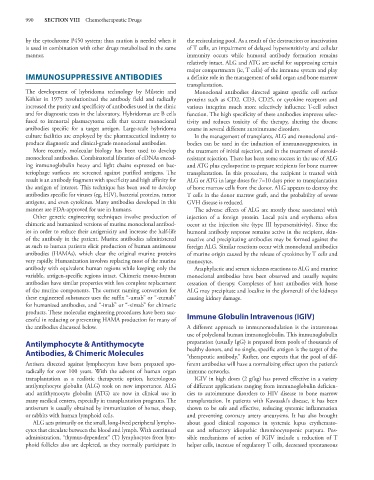Page 1004 - Basic _ Clinical Pharmacology ( PDFDrive )
P. 1004
990 SECTION VIII Chemotherapeutic Drugs
by the cytochrome P450 system; thus caution is needed when it the recirculating pool. As a result of the destruction or inactivation
is used in combination with other drugs metabolized in the same of T cells, an impairment of delayed hypersensitivity and cellular
manner. immunity occurs while humoral antibody formation remains
relatively intact. ALG and ATG are useful for suppressing certain
major compartments (ie, T cells) of the immune system and play
IMMUNOSUPPRESSIVE ANTIBODIES a definite role in the management of solid organ and bone marrow
transplantation.
The development of hybridoma technology by Milstein and Monoclonal antibodies directed against specific cell surface
Köhler in 1975 revolutionized the antibody field and radically proteins such as CD2, CD3, CD25, or cytokine receptors and
increased the purity and specificity of antibodies used in the clinic various integrins much more selectively influence T-cell subset
and for diagnostic tests in the laboratory. Hybridomas are B cells function. The high specificity of these antibodies improves selec-
fused to immortal plasmacytoma cells that secrete monoclonal tivity and reduces toxicity of the therapy, altering the disease
antibodies specific for a target antigen. Large-scale hybridoma course in several different autoimmune disorders.
culture facilities are employed by the pharmaceutical industry to In the management of transplants, ALG and monoclonal anti-
produce diagnostic and clinical-grade monoclonal antibodies. bodies can be used in the induction of immunosuppression, in
More recently, molecular biology has been used to develop the treatment of initial rejection, and in the treatment of steroid-
monoclonal antibodies. Combinatorial libraries of cDNAs encod- resistant rejection. There has been some success in the use of ALG
ing immunoglobulin heavy and light chains expressed on bac- and ATG plus cyclosporine to prepare recipients for bone marrow
teriophage surfaces are screened against purified antigens. The transplantation. In this procedure, the recipient is treated with
result is an antibody fragment with specificity and high affinity for ALG or ATG in large doses for 7–10 days prior to transplantation
the antigen of interest. This technique has been used to develop of bone marrow cells from the donor. ALG appears to destroy the
antibodies specific for viruses (eg, HIV), bacterial proteins, tumor T cells in the donor marrow graft, and the probability of severe
antigens, and even cytokines. Many antibodies developed in this GVH disease is reduced.
manner are FDA-approved for use in humans. The adverse effects of ALG are mostly those associated with
Other genetic engineering techniques involve production of injection of a foreign protein. Local pain and erythema often
chimeric and humanized versions of murine monoclonal antibod- occur at the injection site (type III hypersensitivity). Since the
ies in order to reduce their antigenicity and increase the half-life humoral antibody response remains active in the recipient, skin-
of the antibody in the patient. Murine antibodies administered reactive and precipitating antibodies may be formed against the
as such to human patients elicit production of human antimouse foreign ALG. Similar reactions occur with monoclonal antibodies
antibodies (HAMAs), which clear the original murine proteins of murine origin caused by the release of cytokines by T cells and
very rapidly. Humanization involves replacing most of the murine monocytes.
antibody with equivalent human regions while keeping only the Anaphylactic and serum sickness reactions to ALG and murine
variable, antigen-specific regions intact. Chimeric mouse-human monoclonal antibodies have been observed and usually require
antibodies have similar properties with less complete replacement cessation of therapy. Complexes of host antibodies with horse
of the murine components. The current naming convention for ALG may precipitate and localize in the glomeruli of the kidneys
these engineered substances uses the suffix “-umab” or “-zumab” causing kidney damage.
for humanized antibodies, and “-imab” or “-ximab” for chimeric
products. These molecular engineering procedures have been suc- Immune Globulin Intravenous (IGIV)
cessful in reducing or preventing HAMA production for many of
the antibodies discussed below. A different approach to immunomodulation is the intravenous
use of polyclonal human immunoglobulin. This immunoglobulin
Antilymphocyte & Antithymocyte preparation (usually IgG) is prepared from pools of thousands of
Antibodies, & Chimeric Molecules healthy donors, and no single, specific antigen is the target of the
“therapeutic antibody.” Rather, one expects that the pool of dif-
Antisera directed against lymphocytes have been prepared spo- ferent antibodies will have a normalizing effect upon the patient’s
radically for over 100 years. With the advent of human organ immune networks.
transplantation as a realistic therapeutic option, heterologous IGIV in high doses (2 g/kg) has proved effective in a variety
antilymphocyte globulin (ALG) took on new importance. ALG of different applications ranging from immunoglobulin deficien-
and antithymocyte globulin (ATG) are now in clinical use in cies to autoimmune disorders to HIV disease to bone marrow
many medical centers, especially in transplantation programs. The transplantation. In patients with Kawasaki’s disease, it has been
antiserum is usually obtained by immunization of horses, sheep, shown to be safe and effective, reducing systemic inflammation
or rabbits with human lymphoid cells. and preventing coronary artery aneurysms. It has also brought
ALG acts primarily on the small, long-lived peripheral lympho- about good clinical responses in systemic lupus erythemato-
cytes that circulate between the blood and lymph. With continued sus and refractory idiopathic thrombocytopenic purpura. Pos-
administration, “thymus-dependent” (T) lymphocytes from lym- sible mechanisms of action of IGIV include a reduction of T
phoid follicles also are depleted, as they normally participate in helper cells, increase of regulatory T cells, decreased spontaneous

